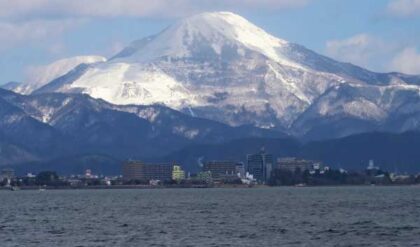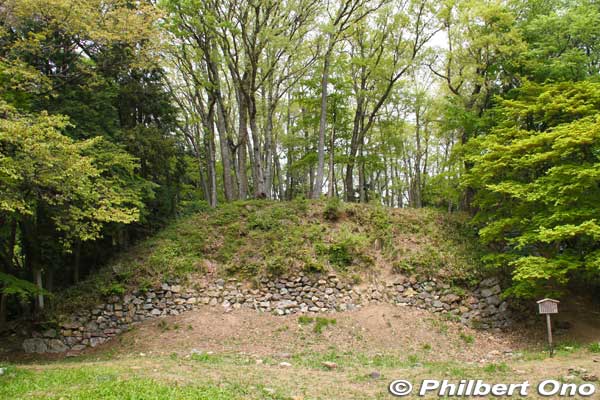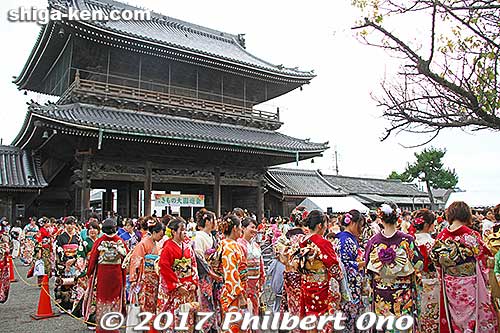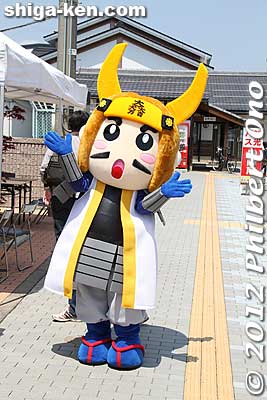
As I mentioned earlier, Nagahama is holding another feudal history expo this year called Nagahama Sengoku Taiga Furusato-haku (長浜・戦国大河ふるさと博) (Nagahama Warring States Hometown Expo) from March 24 to Dec. 2, 2012. This is their followup to last year’s Go and Azai Sisters Expo held in conjunction with last year’s year-long NHK Taiga Drama Go – Sengoku no Himetachi. I finally went to see this year’s expo in early May.
Compared to last year’s expo, I found a few new (and old) things. Last year, they focused on the NHK Taiga Drama characters and Odani Castle. This year, the focus is on the Battle of Shizugatake and the Battle of Anegawa with side attractions Odani Castle and Chikubushima island. Like last year, there are a few small pavilions, shuttle buses going to expo attractions, gift shops, an official mascot, and human guides to explain things. And like last year, nothing is in English. Expo organizers either don’t have the budget for foreign language translations or they are not aware of how popular Japanese feudal characters are outside Japan, especially in anime, manga, and video games. The Otsu-centric Biwako Visitors Bureau also has absolutely no foreign-language information about this expo, as of this writing.
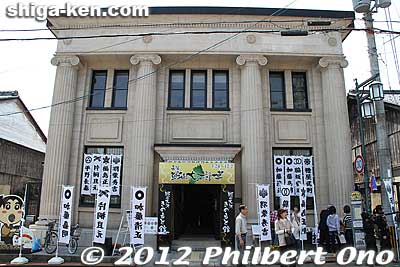
What’s totally new is the main expo pavilion in Kinomoto called Sengoku Taiga Kinomoto-kan (戦国大河きのもと館). A short walk from JR Kinomoto Station, the pavilion (in a former bank building) has exhibits centering on the Battle of Shizugatake, a pivotal battle in May 1583 between Toyotomi Hideyoshi and Shibata Katsuie who lost. Hideyoshi’s victory solidified his claim to succeed the assassinated Oda Nobunaga as Japan’s most powerful warlord. There are pavilion guides who explain about the exhibits and battle. Admission is 300 yen.
Mt. Shizugatake is part of the Kinomoto expo site and it is one of Shiga’s must-see sights. A chair lift takes you to the top for splendid views of Lake Biwa and Lake Yogo. There’s also a samurai monument memorializing the Battle of Shizugatake. If you have a few hours to spare, you can also hike down to Lake Yogo and catch the train back from Yogo Station. JR Kinomoto Station has shuttle buses going to Mt. Shizugatake every 30 min. from 9:45 am to 4:15 pm. Round trip bus fare is 300 yen.
If you plan to visit both the Kinomoto Pavilion and Mt. Shizugatake, buy the Kinomoto set ticket for 1,000 yen which includes admission to the Kinomoto Pavilion, roundtrip shuttle bus from Kinomoto Station to Mt. Shizugatake, and roundtrip chair lift on Mt. Shizugatake. Otherwise, the roundtrip bus fare will be 300 yen, chair lift 760 yen, and Kinomoto Pavilion admission 300 yen. (Half price for kids up to junior high school.) While in Kinomoto, also stop by to see the Kinomoto Jizo-in temple with its giant Jizo statue.
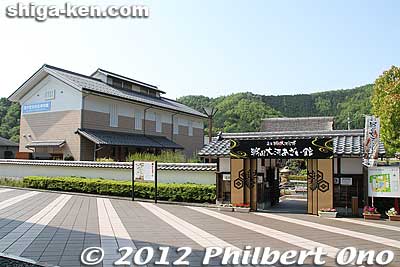
The second pavilion is the Azai Pavilion which is actually the Azai Folk History Museum (Azai Rekishi Minzoku Shiryokan 浅井歴史民俗資料館), a museum complex of two thatched-roof houses and a modern museum surrounding a small Japanese garden. The modern museum has exhibits on the Battle of Anegawa and the attack on Odani Castle when Ichi escaped with her three daughters (the Azai sister trio). Note that this museum complex is a permanent facility so it will still remain after the expo ends. It has been around for years and worth a visit. Museum admission is 300 yen.
The third pavilion is in central Nagahama across from the Nagahama Hikiyama Festival Museum, a short walk from Nagahama Station. The Nagahama Pavilion shows the history of the NHK Taiga Drama series over the last 50 years. It’s in the same space as last year’s Go and Azai Sisters Expo’s Nagahama Pavilion with almost the same kind of exhibits with kimono, samurai armor, and a mini theater showing clips from NHK Taiga Dramas. Pavilion admission is 300 yen. If you want to also see the Hikiyama Museum (mainly festival floats), it’s 600 yen for admission to both. The expo pavilions are open from 9 am to 5 pm (enter by 4:30 pm).
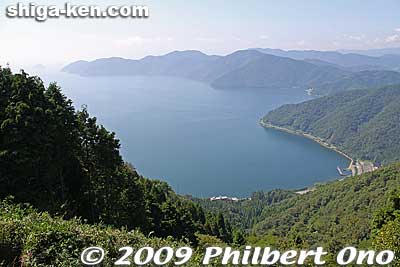
Besides the pavilions, Mt. Shizugatake, Chikubushima island, and Odani Castle are also official expo sites. If you’ve been there already, you don’t really need to visit them during the expo. Otherwise, these sites are a must-see for history buffs. Visiting Mt. Shizugatake and Odani Castle during the expo is very convenient because shuttle buses run much more frequently than usual.
Odani Castle, home of Azai Nagamasa, wife Ichi (Oichi), and their three daughters Chacha, Hatsu, and Go (Azai sister trio), was the star of last year’s expo. By including it in this year’s expo, they continue to provide convenient shuttle buses from Nagahama Station (west side) running every 30 min. or so from 9:20 am to 4:40 pm on weekends (on weekdays, every 40 min. from 9:40 am to 4:10 pm). Bus fare is 500 yen for an all-day pass.
What’s new from last year are expanded tours of Odani Castle. Last year, the Odani Castle guided tours took you only to the Honmaru mound and back. This year, they offer longer optional tours which can take you as far as the summit of Mt. Odani (elevation 495 meters) and even 5-hour hikes to visit all the castle ruins along the mountain ridges or hike down to the adjacent valley where the castle lord and samurai normally lived. Even the basic tour has been slightly expanded to include visits to the Akao Yashiki residence site where Azai Nagamasa committed seppuku and to Nakamaru Toraguchi, a ravine right behind the Honmaru mound.
The basic tour (基本コース) takes 100 min. including roundtrip bus ride and costs 500 yen. The basic tours start at 9:30 am, 11 am, 12:30 pm, and 2 pm from the Sengoku Guide Station (which served as the Odani pavilion last year). There’s an additional tour at 3:30 pm from July 21 to Aug. 31. First you have to take the shuttle bus from Nagahama Station to get to the Sengoku Guide Station at the foot of Mt. Odani. Then take another bus (500 yen roundtrip) at the Sengoku Guide Station to go almost halfway up Mt. Odani taking about 5-10 min. They will take you to the Honmaru mound and back, an easy walk.
There are four Optional tours which require reservations by phone and at least five people in a tour group. If you don’t have five people, you could join another group going at the same time. Call and make reservations with the Sengoku Guide Station (phone: 0749-78-0300). The basic tours do not require reservations. The castle tour guides are Japanese-speaking only.
Here are the Optional tours (オプションコース) offered. They start at different times from the basic tours. To the cost, add 500 yen for the shuttle bus (roundtrip) to go up Mt. Odani from Sengoku Guide Station office at the foot of Mt. Odani.
- Course A (Aコース): This guided tour goes beyond the Honmaru mound up to the Sanno-maru (山王丸). An easy hike and I recommend this tour if you have the time. The tour is 2.5 hours and 500 yen.
- Course B: This guided tour goes up to Sanno-maru, then down to Shimizu Valley below before returning to the Sengoku Guide Station. In the valley, there are only stone markers showing the former sites of the castle palace, etc. The tour is 2.5 hours and 1000 yen.
- Course C: This guided tour takes you to the summit of Mt. Odani (elevation 495 meters) and to the opposite mountain ridge to see more castle ruins. For hardcore castle fans. The tour is 5 hours and 1500 yen.
- Course D: This guided tour takes you to the summit of Mt. Odani (elevation 495 meters), then down to Shimizu Valley. The tour is 5 hours and 1500 yen.
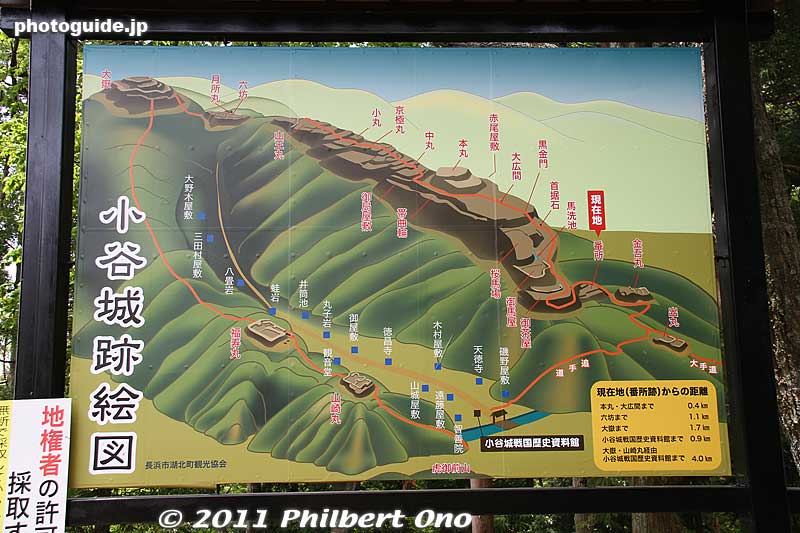
It’s possible to hike up Mt. Odani from the foot for free on your own, but I recommend taking the bus up and going with a guide (Japanese-speaking only). If you hike up on your own, be sure to follow the road and regular hiking path. Don’t enter any blocked-off path, etc. You shouldn’t wear high heels or slippers since there are gravel and rocky slopes. The basic tour doesn’t require hiking gear, but the longer optional tours require hiking shoes. There are no vending machines on Mt. Odani so bring our own food and drinks. In summer, there will be lots of flying bugs so a paper fan will come in handy.

To visit Chikubushima, just walk 15 min. (or take a taxi) to Nagahama Port from Nagahama Station. The boat fare is 2,980 yen roundtrip and admission to Chikubushma is 400 yen. You don’t have to visit it during the expo since it won’t go away, but it is one of Shiga’s major sights.
Although the expo is not as big or popular as last year’s, it’s a decent effort to promote tourism. One vital element is the public transportation to the pavilions and sites. There are three separate shuttle bus lines for the expo. Each one charges a separate bus fare. There is no bus pass good on all three shuttle bus lines. The shuttle bus in Kinomoto (called Shichihon-yari Bus 七本槍バス) runs between JR Kinomoto Station and Mt. Shizugatake. The main shuttle bus (called Sengoku Bus 戦国バス) runs in central Nagahama from JR Nagahama Station to the Azai Pavilion (Azai Folk History Museum) and Sengoku Guide Station at the foot of Mt. Odani. The third shuttle bus line runs between the Sengoku Guide Station at the foot of Mt. Odani and the Bansho (番所) area almost halfway up Mt. Odani from where you can walk/hike to see the castle ruins. Also, the bus going up Mt. Odani will not run during June 1 to July 20 and on foul weather days. The exact shuttle bus schedule in Japanese is here.
There is no bus connecting Kinomoto and central Nagahama. You have to travel by train between Kinomoto and Nagahama Stations.
I’m still puzzled as to why they did not include the Ishida Mitsunari Birthplace and the Battle of Anegawa Site on the shuttle bus route. After all, the expo focuses on Nagahama-native Mitsunari (official mascot is Mitsunari-kun) as well as the Battle of Anegawa. However, these sites are still accessible by local buses from Nagahama Station. Nagahama Castle, a short walk from Nagahama Station, is not part of the expo either.
More photos of the expo here. (Or click on an image in this post.)
Official site here (in Japanese).




